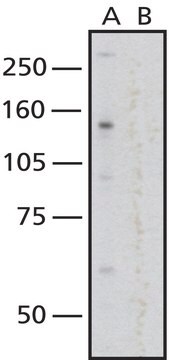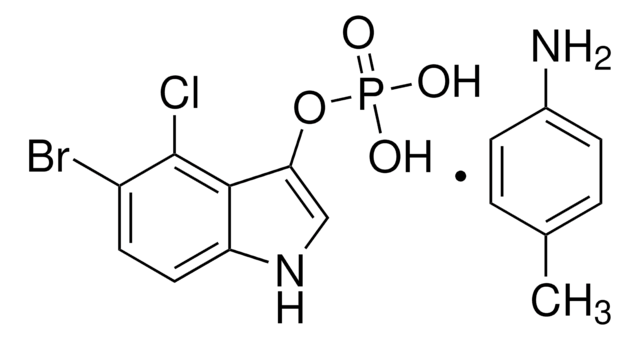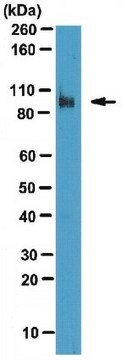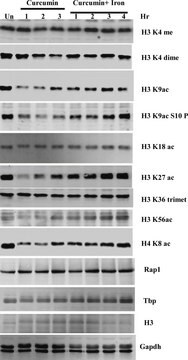MABS1267
Anti-Nuclear Pore Complex Proteins Antibody, clone 414
clone 414, from mouse
Sinonimo/i:
Nuclear pore glycoprotein p62, 62 kDa nucleoporin, Nucleoporin Nup62, Nuclear pore complex proteins
About This Item
Prodotti consigliati
Origine biologica
mouse
Livello qualitativo
Forma dell’anticorpo
purified immunoglobulin
Tipo di anticorpo
primary antibodies
Clone
414, monoclonal
Reattività contro le specie
yeast, mouse, rat, human
tecniche
electron microscopy: suitable
immunocytochemistry: suitable
immunoprecipitation (IP): suitable
western blot: suitable
Isotipo
IgG1κ
N° accesso NCBI
N° accesso UniProt
modifica post-traduzionali bersaglio
unmodified
Informazioni sul gene
human ... NUP62(23636)
Descrizione generale
Specificità
Immunogeno
Applicazioni
Immunocytochemistry Analysis: A representative lot immunostained yeast nuclear envelope with a punctate and patchy pattern (Aris, J.P., and Blobel, G. (1989). J. Cell Biol. 108(6):2059-2067).
Immunocytochemistry Analysis: Representative lots detected a punctate staining pattern of Nup62 at the nuclear rim by fluorescent immunocytochemistry using 2% formaldehyde-fixed, methanol-permeabilized Buffalo rat liver (BRL) cells (Davis, L.I., and Blobel, G. (1987). Proc. Natl. Acad. Sci. U. S. A. 84(21):7552-755; Davis, L.I., and Blobel, G. (1986). Cell. 45(5):699-709).
Electron Microscopy: A representative lot immunostained yeast nuclear envelope using 3% paraformaldehyde/0.2% glutaraldehyde-fixed yeast nuclei LR White sections (Aris, J.P., and Blobel, G. (1989). J. Cell Biol. 108(6):2059-2067).
Electron Microscopy: A representative lot immunostained the pore complexes in thin sections of isolated rat liver nuclei extracted with 2% Triton X-100 and fixed with 0.05% glutaraldehyde (Davis, L.I., and Blobel, G. (1986). Cell. 45(5):699-709).
Immunoprecipitation Analysis: A representative lot immunoprecipited a ~100 kDa (p110) and a ~95 kDa (p95) protein species from yeast nuclear extract. An additional ~55 kDa protein was immunoprecipitated by clone 414 using yeast cytosolic fraction or whole cell lysate (Aris, J.P., and Blobel, G. (1989). J. Cell Biol. 108(6):2059-2067).
Immunoprecipitation Analysis: A representative lot immunoprecipitated three major GlcNAcylated prtoein species of 62, 175, and 270 kDa from SDS-solubilized pore complex-lamina extract of Buffalo rat liver (BRL) cell nuclei preparation that had been labeled with UDP-[3H]Gal by galactosyltransferase (Davis, L.I., and Blobel, G. (1987). Proc. Natl. Acad. Sci. U. S. A. 84(21):7552-755).
Immunoprecipitation Analysis: A representative lot immunoprecipitated GlcNAcylated 62 kDa protein (p62) from the SDS-solubilized pore complex-lamina extract, as well as a less glycosylated p61 cytoplasmic form from the postmitochondrial supernatant of Buffalo rat liver (BRL) cells (7552-755; Davis, L.I., and Blobel, G. (1986). Cell. 45(5):699-709).
Western Blotting Analysis: A representative lot detected a ~100 kDa (p110) and a ~95 kDa (p95) immunoreactive bands in yeast nuclear extract (Aris, J.P., and Blobel, G. (1989). J. Cell Biol. 108(6):2059-2067).
Western Blotting Analysis: A representative lot detected a ~62 kDa (p62) and a ~200 kDa target bands associated with nuclear pore complex-lamina of rat liver nuclei preparation even following sequential nucleaases, Triton X-100, and 140 mM NaCl treatments (Davis, L.I., and Blobel, G. (1986). Cell. 45(5):699-709).
Signaling
Chromatin Biology
Qualità
Immunocytochemistry Analysis: A 1:200 dilution of this antibody immunostained HeLa cell nuclear rim.
Descrizione del bersaglio
Stato fisico
Stoccaggio e stabilità
Altre note
Esclusione di responsabilità
Non trovi il prodotto giusto?
Prova il nostro Motore di ricerca dei prodotti.
Codice della classe di stoccaggio
12 - Non Combustible Liquids
Classe di pericolosità dell'acqua (WGK)
WGK 1
Punto d’infiammabilità (°F)
Not applicable
Punto d’infiammabilità (°C)
Not applicable
Certificati d'analisi (COA)
Cerca il Certificati d'analisi (COA) digitando il numero di lotto/batch corrispondente. I numeri di lotto o di batch sono stampati sull'etichetta dei prodotti dopo la parola ‘Lotto’ o ‘Batch’.
Possiedi già questo prodotto?
I documenti relativi ai prodotti acquistati recentemente sono disponibili nell’Archivio dei documenti.
Il team dei nostri ricercatori vanta grande esperienza in tutte le aree della ricerca quali Life Science, scienza dei materiali, sintesi chimica, cromatografia, discipline analitiche, ecc..
Contatta l'Assistenza Tecnica.








